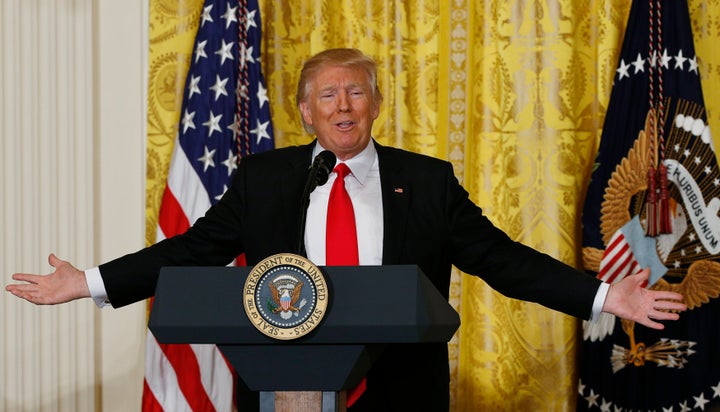
There is something curious about Donald Trump’s deliberate and repeated provocations of the news media. The most extreme so far was his declaration last week that several of the nation’s oldest and best-known news organizations are “enemies of America”. We can’t know for sure, but this may have been the first time in the history of the Republic that all 39 of the people who signed the Constitution rolled over in their graves.
Does Trump malign the news media because he relishes a good fight? Does he hope to intimidate the networks so they stop contradicting him? Or is he trying to undermine public trust in the institution the architects of our democracy considered vital to “effectively expose deception in government”?
Trump’s enemies list was interesting, too, for the news outlets that were not on it, among them Fox News and the Breitbart News Network. Trump, who has access to more reliable information, intelligence and world-class experts than any other person on the planet, watches Fox News so often that the station’s personalities talk to him directly on the air.
So, it appears that our president gets many of his “facts” from the network consistently ranked over the years as the least trustworthy and most inaccurate news organization on cable television. One study five years ago found that people who watched Fox News knew less about national issues than people who watched no news at all. Journalist Chris Mooney, who reviewed a body of research on the “Fox News effect” over the last decade, concluded that it and similar ideological news organizations are “polarizing America not only over politics, but over reality itself.”
As PolitiFact has tabulated ― and as humorist John Oliver pointed out in a disturbing expose on where Trump gets his information ― the president’s statements are true or mostly true only 16% of the time.
There is little question that the news business is a mess these days, in part because everybody in the world with access to the Web can purvey unedited and unverified information. But some history is important to better understand the state of our more conventional news media.
In 1949, the Federal Communications Commission (FCC) created the Fairness Doctrine because of concerns that NBC, ABC and CBS could use their dominance of television to broadcast a biased public agenda. Under the Doctrine, stations could not keep their broadcast licenses unless they aired both sides of controversial issues.
Congress endorsed the Doctrine in 1954 and the U.S. Supreme Court upheld it in 1969. The FCC called the Doctrine the “single most important requirement of operation in the public interest”. Nevertheless, the FCC stopped enforcing it during the Reagan Administration, repealed it in 1987 and erased the Doctrine completely from its books in 2011, reasoning it was obsolete because the many news outlets available today allow citizens to channel-surf for opposing views.
But that is not what has happened. Instead, news outlets emerged with one-sided ideological agendas. Many viewers and listeners who share those ideologies tune in and remain tuned in because as psychologist Robert Altemeyer notes, people maintain their beliefs by “surrounding themselves with sources of information that will tell them they are right.” One result is that people’s views are continuously fortified and become more rigid.
Fox News reinforces its echo chamber by telling its viewers that other news outlets are biased against them. “Conservatives duly respond by saying other media aren’t worth watching,” Mooney notes. Bruce Bartlett, an American historian who was Ronald Reagan’s domestic policy advisor, has reviewed relevant research on our news habits and has found “Many conservatives now refuse to even listen to any news or opinion not vetted through Fox, and to believe whatever appears on it as the gospel truth.”
So back to my opening question: Why has the President worked so hard to make war against the mainstream news media? For one thing, his base loves it. For another, he might expand his base by driving more voters to watch conservative and altRight outlets like Fox and Breitbart.
There may be another reason: Trump’s attacks on mainstream news and the courts could be designed to undermine public support for two institutions whose job is to check abuses of presidential power. This may simply be habit. Trump is accustomed to autocratic control of his business empire and he does not like to be challenged. Over time, he might settle in to the far different job of the presidency.
Or his provocations of the press and the courts could be more nefarious – a strategy encouraged by any Rasputins in his circle to expand the president’s unchecked powers.
In either case, the courts and news media cannot allow themselves to be intimidated as Trump puts “bully” back into the bully pulpit. This president and his Cabinet have less experience in government and more potential conflicts of interests than any in our history. The job of checks and balances the Founders assigned to the news media, the courts and Congress, too, is as important as ever. As for the rest of us, it’s time to insist that the FCC reinstate an updated version of the Fairness Doctrine.
***
In this time of “alternative facts” and “false news”, it’s a good idea to consult the several fact-checking organizations available on the Internet. You’ll find six of them here.
